中考英语-最易混淆的完全否定与部分否定
中考英语否定用法易混易错考点剖析(三)
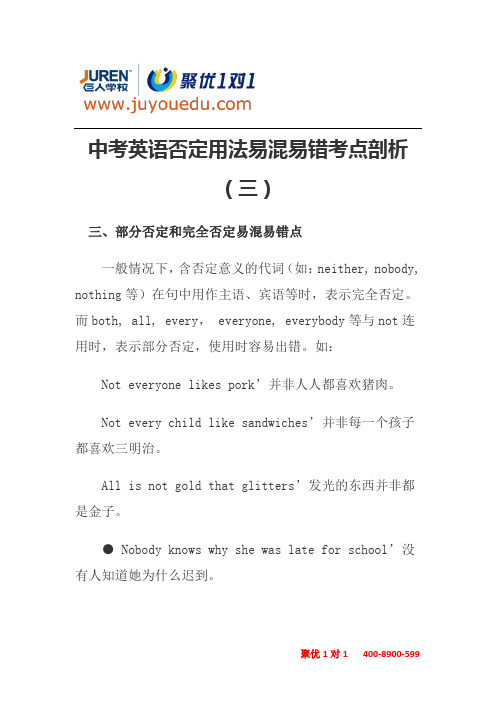
中考英语否定用法易混易错考点剖析(三)三、部分否定和完全否定易混易错点一般情况下,含否定意义的代词(如:neither, nobody, nothing等)在句中用作主语、宾语等时,表示完全否定。
而both, all, every, everyone, everybody等与not连用时,表示部分否定,使用时容易出错。
如:Not everyone likes pork’并非人人都喜欢猪肉。
Not every child like sandwiches’并非每一个孩子都喜欢三明治。
All is not gold that glitters’发光的东西并非都是金子。
● Nobody knows why she was late for school’没有人知道她为什么迟到。
句中的Nobody不能写成Everyone/ Everybody。
复合代词Nobody在句中用作主语,表示完全否定。
如果把Nobody 改成Everyone/ Everybody ,该句就成了肯定句。
表示完全否定的词除了代词之外,还有形容词、介词、副词等。
如:Nothing makes him change his mind’没有什么能使他改变主意。
I have never seen such wonderful films’我从未看过这么好的影片。
【中考链接】1 (2010年苏州卷)—Wow! You’ve got so many skirts’—But CD#4 of them are in fashion nowA.allB.both ’C.neither’D.none’2 (2011年福州卷)—CD#4 Mary CD#4 Alice has joined the music club because they have no time’—It’s a pityA.Both; andB.Either; or’C.Neither; nor3 (2011年成都卷)There’s CD#4 wrong with the camera’Look! It works well’A.somethingB.nothingC.everything’HJ2 6mm【简析】1’D。
英语中的部分否定与全部否定
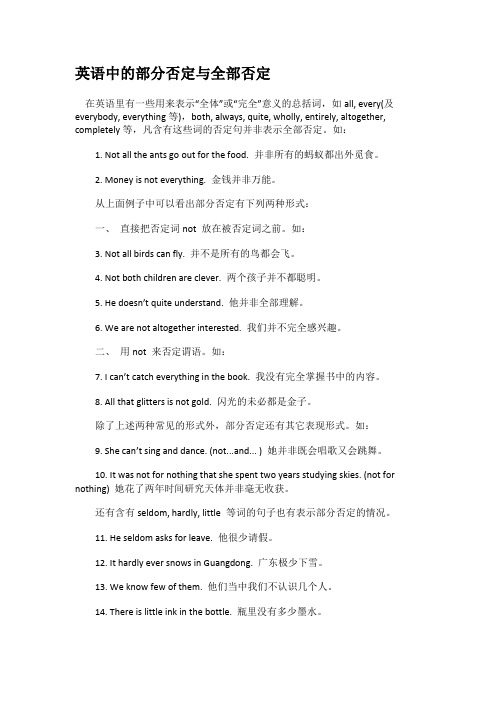
英语中的部分否定与全部否定在英语里有一些用来表示“全体”或“完全”意义的总括词,如all, every(及everybody, everything等),both, always, quite, wholly, entirely, altogether, completely等,凡含有这些词的否定句并非表示全部否定。
如:1. Not all the ants go out for the food. 并非所有的蚂蚁都出外觅食。
2. Money is not everything. 金钱并非万能。
从上面例子中可以看出部分否定有下列两种形式:一、直接把否定词not 放在被否定词之前。
如:3. Not all birds can fly. 并不是所有的鸟都会飞。
4. Not both children are clever. 两个孩子并不都聪明。
5. He doesn’t quite understand. 他并非全部理解。
6. We are not altogether interested. 我们并不完全感兴趣。
二、用not 来否定谓语。
如:7. I can’t catch everything in the book. 我没有完全掌握书中的内容。
8. All that glitters is not gold. 闪光的未必都是金子。
除了上述两种常见的形式外,部分否定还有其它表现形式。
如:9. She can’t sing and dance. (not...and... ) 她并非既会唱歌又会跳舞。
10. It was not for nothing that she spent two years studying skies. (not for nothing) 她花了两年时间研究天体并非毫无收获。
还有含有seldom, hardly, little 等词的句子也有表示部分否定的情况。
11. He seldom asks for leave. 他很少请假。
部分否定和完全否定[1]
![部分否定和完全否定[1]](https://img.taocdn.com/s3/m/0373d6de05087632311212d1.png)
若要表示全部否定,则应用相 应的表示全部否定的否定词。
all → none (一个人也没有、没有 任何东西), both → neither (两个都不), every → no,
everyone → no one(nobody),
everything → nothing 等。
其他否定形式
1. 借助否定词not,no,never,none, nobody,nothing,nowhere等来表达 否定之意. 2. 借助半否定词hardly,scarcely, seldom,little,few等来表达否定之意. 3. 借助否定前缀a-,ab-,an-,de-, dis-,il-,im-,in-达否定之意; 也可以用后缀 -less,-free,-proof等 构成的词表达否定之意。
______ likes money, but money is not _________ .
A.Everyone; everything B.Anyone; anything C.Someone; nothing D.Nobody; everything
部分否定和全部否定 1.Not all birds can fly. =All birds can not fly =Some birds can’t fly 不是所有的鸟都会飞
三、 every…的否定式:"不是每…… 都……" Not every book is educative. (或: Every book is not educative.) Not everyone likes this book. This flower is not seen everywhere. 四、 always的否定式:“并非总是(并 非一直)……” He is not always so sad.
部分否定、全部否定和混合否定用法解析

部分否定、全部否定和混合否定用法解析英语否定句部分否定、全部否定和混合否定用法解析一、部分否定all,both,every,everybody,everyday,everyone,many,everything,entirely,each、altogether,absolutely,wholly,completely,everywhere,always,often等与否定词not搭配使用。
常常翻译为“并非所有,并不是都。
如:all…not (不全是,不都是),both…not(并非两个都,不是两者都),every…not(不是每个都),not always(不总是,不一定),not often(不经常),not altogether(不全是),not necessarily (未必)等。
We couldn't eat in a restaurant because none of us had any money on us我们不能在饭店吃饭,因为我们谁都没有带钱。
All that glitters is not gold. (莎士比亚语)=Not all that glitters is gold. 闪闪发光的未必都是金子。
Both the windows are not open.两扇窗户并不都是开着的。
Everybody does not believe the rumor.并不是每个人都听信这个谣言的。
They are not always in the office on Sundays.他们不一定每个星期天都在办公室。
The responsibility is not altogether mine.责任并不全在于我身上。
The situation is not necessarily so.情况并非如此。
I agree with most of what you said, but I don't agree with everything.我同意你所说的大部分话,但是我不同意你所说所有话。
英语常见疑难问题-否定

整个句子的否定
1.No one of us/none of us 都表示对整个句子 的否定。 2.部分否定句和全部否定句。例如,no work will kill him.一是分析为局部否定句,(no work)+(will kill him.)翻译为 没有工作 会把他憋死。二是全部否定句,(no ) (work will kill him)翻译为 工作绝不会压 垮他,用逻辑术语来讲,work will kill him 表示一个假设判断,而no work will kill him 表示这个判断是错误的,也就是说这个假 设情况是不存在的。
否定范围
• 否定范围自否定词起一直延伸到句末。例 如,He did not come to work by bus.他没 有乘公共车来上班。 • 否定范围自否定词起一直到句末修饰性状 语之前便告终止。例如,we have no other tools besides this.我们没有别的工具,除了 这个。 • 由于英语否定范围由以上两种情况,所以 英语否定往往有歧义。
永远位于否定范围之内的壮语 compelety,greatly,,silghtly,for sure,for certain等。例如,I do not know for sure he is dead.翻译为 我不确切知道他死了。 既可位于否定范围之内又可位于否定范围 之外的状语。 actually difinitely,certainly,really。 不在否定范围之内的壮语
英语常见疑难问题
否定
全部否定与部分否定
1.all...not/both...not一般情况下表示部分否定,但是
它本身是个有歧义的结构,它既可以表示部分否 定也可以表示全部否定。例如:Not all of the arrows hit the targets.(并不是所有的箭都射中了 靶子/所有的箭都没射中靶子)所以在没有上下文 的情况下它的翻译有两种。 2.no+职业表示既可能是否定职业也可能是否定从事 某种职业的特征、技巧、素养等。例如:I am not teacher.(我不是教师/我不善于教书)
高考英语中的八种否定形式,千万别混淆!
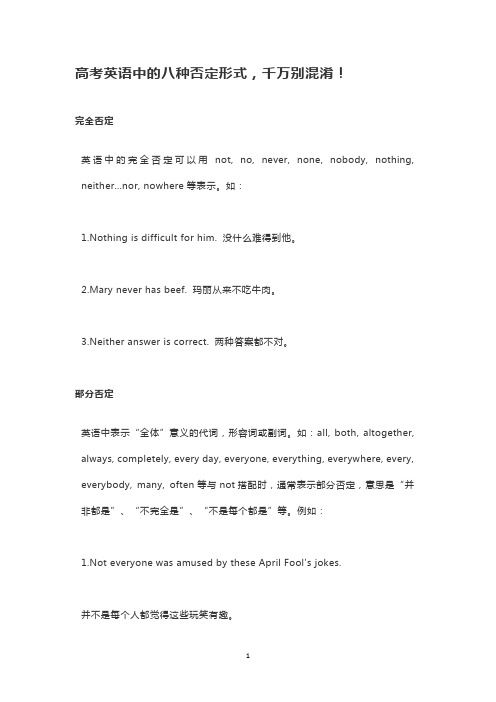
高考英语中的八种否定形式,千万别混淆!完全否定英语中的完全否定可以用not, no, never, none, nobody, nothing, neither...nor, nowhere等表示。
如:1.Nothing is difficult for him. 没什么难得到他。
2.Mary never has beef. 玛丽从来不吃牛肉。
3.Neither answer is correct. 两种答案都不对。
部分否定英语中表示“全体”意义的代词,形容词或副词。
如:all, both, altogether, always, completely, every day, everyone, everything, everywhere, every, everybody, many, often等与not搭配时,通常表示部分否定,意思是“并非都是”、“不完全是”、“不是每个都是”等。
例如:1.Not everyone was amused by these April Fool's jokes.并不是每个人都觉得这些玩笑有趣。
2.Food likes and dislikes do not always seem related to nutrition. 对食物的好恶似乎并不总与营养有关。
比较:Nothing makes him happy.(全部否定)没有哪一件事情让他开心。
Not everything makes him happy.(部分否定)并不是每一件事都让他开心。
None of the students went to visit the science museum last week.(完全否定)上周没有一个学生去参观科技博物馆。
Not all of the students went to visit the science museum last week.(部分否定)上周并不是所有的学生都去参观了科技博物馆。
英语中部分否定与全部否定的用法
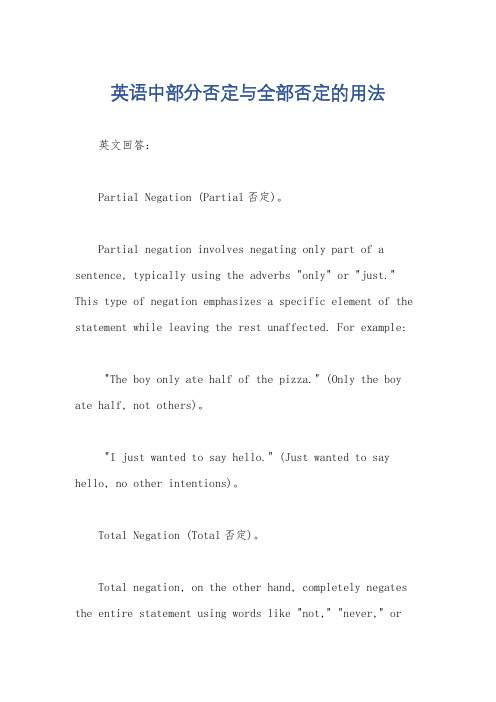
英语中部分否定与全部否定的用法英文回答:Partial Negation (Partial否定)。
Partial negation involves negating only part of a sentence, typically using the adverbs "only" or "just." This type of negation emphasizes a specific element of the statement while leaving the rest unaffected. For example:"The boy only ate half of the pizza." (Only the boy ate half, not others)。
"I just wanted to say hello." (Just wanted to say hello, no other intentions)。
Total Negation (Total否定)。
Total negation, on the other hand, completely negates the entire statement using words like "not," "never," or"no." It expresses a complete absence or lack of something. Examples include:"The boy did not eat the pizza." (He didn't eat any of it)。
"I have never been to Paris." (Not even once)。
中考初中英语八种否定句形式汇总
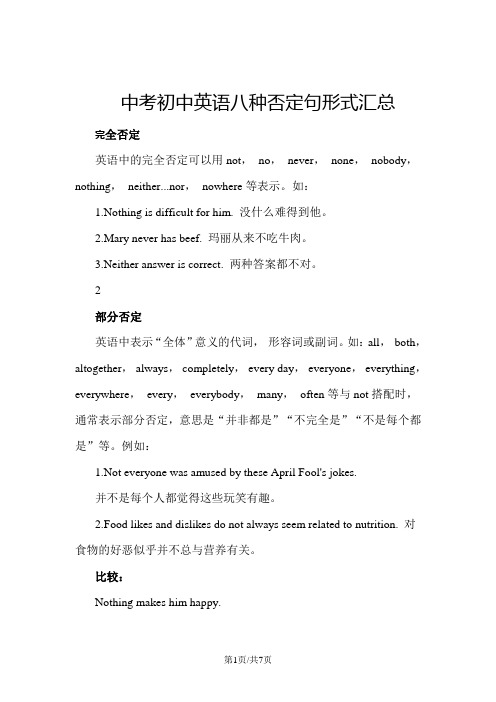
中考初中英语八种否定句形式汇总完全否定英语中的完全否定可以用not,no,never,none,nobody,nothing,neither...nor,nowhere等表示。
如:1.Nothing is difficult for him. 没什么难得到他。
2.Mary never has beef. 玛丽从来不吃牛肉。
3.Neither answer is correct. 两种答案都不对。
2部分否定英语中表示“全体”意义的代词,形容词或副词。
如:all,both,altogether,always,completely,every day,everyone,everything,everywhere,every,everybody,many,often等与not搭配时,通常表示部分否定,意思是“并非都是”“不完全是”“不是每个都是”等。
例如:1.Not everyone was amused by these April Fool's jokes.并不是每个人都觉得这些玩笑有趣。
2.Food likes and dislikes do not always seem related to nutrition. 对食物的好恶似乎并不总与营养有关。
比较:Nothing makes him happy.(全部否定)没有哪一件事情让他开心。
Not everything makes him happy.(部分否定)并不是每一件事都让他开心。
None of the students went to visit the science museum last week.(完全否定)上周没有一个学生去参观科技博物馆。
Not all of the students went to visit the science museum last week.(部分否定)上周并不是所有的学生都去参观了科技博物馆。
中考英语否定用法易溷易错考点剖析(一)
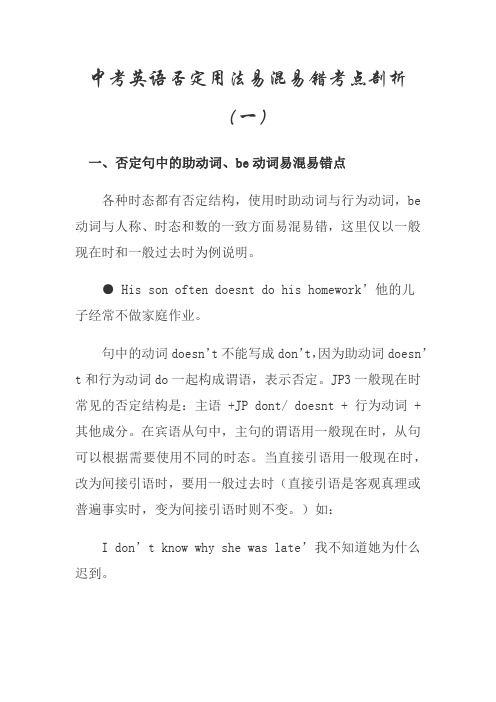
中考英语否定用法易混易错考点剖析(一)一、否定句中的助动词、be动词易混易错点各种时态都有否定结构,使用时助动词与行为动词,be 动词与人称、时态和数的一致方面易混易错,这里仅以一般现在时和一般过去时为例说明。
● His son often doesnt do his homework’他的儿子经常不做家庭作业。
句中的动词doesn’t不能写成don’t,因为助动词doesn’t和行为动词do一起构成谓语,表示否定。
JP3一般现在时常见的否定结构是:主语 +JP dont/ doesnt + 行为动词 + 其他成分。
在宾语从句中,主句的谓语用一般现在时,从句可以根据需要使用不同的时态。
当直接引语用一般现在时,改为间接引语时,要用一般过去时(直接引语是客观真理或普遍事实时,变为间接引语时则不变。
)如:I don’t know why she was late’我不知道她为什么迟到。
The teacher said to us, “The moon isn’t as far as the sun to us ”→ The teacher told us that the moon isn’t as far as the sun to us’老师对我们说:“月亮没有太阳离我们远。
”● I’d like to go fishing with you if it doesn’t rain tomorrow’如果明天不下雨,我想和你一起去钓鱼。
句中的doesn’t 不能写成won’t,因为这是由if引导的条件状语从句,从句中的谓语动词要用一般现在时代替一般将来时。
如:I’ll go with you if he doesnt come’如果他不来,我就和你一起去。
● Two months isnt short, you may have fun’两个月不短,你可以玩得很开心。
句中的isnt不能写成arent。
初三英语中考语法详解(30)不定代词的全部肯定,部分否定,全部否定含义与用法
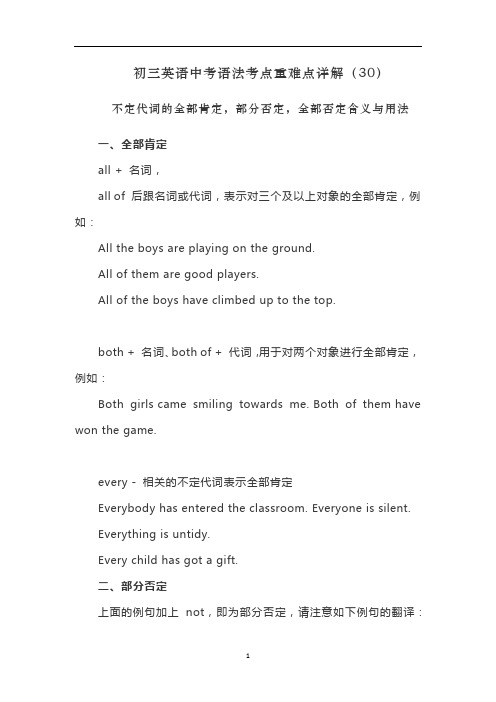
初三英语中考语法考点重难点详解(30)不定代词的全部肯定,部分否定,全部否定含义与用法一、全部肯定all + 名词,all of 后跟名词或代词,表示对三个及以上对象的全部肯定,例如:All the boys are playing on the ground.All of them are good players.All of the boys have climbed up to the top.both + 名词、both of + 代词,用于对两个对象进行全部肯定,例如:Both girls came smiling towards me. Both of them have won the game.every - 相关的不定代词表示全部肯定Everybody has entered the classroom. Everyone is silent.Everything is untidy.Every child has got a gift.二、部分否定上面的例句加上not,即为部分否定,请注意如下例句的翻译:Not all of them are good players. = All of them aren't good players.他们并非全部都是上好的球员。
Not both of them are doctors.他们俩并非都是医生。
(他们俩只有一个是医生)如果要表达“他们俩都不是医生”需要用neither:Neither of them is a doctor.I don't like both of them.我不是两个都不喜欢。
Not everything goes well.并非一切都顺利。
三、全部否定对all 的全部否定None of them are good players.他们中没有一个踢得好的。
Nobody can smoke here. 任何人不能在这抽烟。
英语双重否定、部分否定、全部否定的用法和解析?
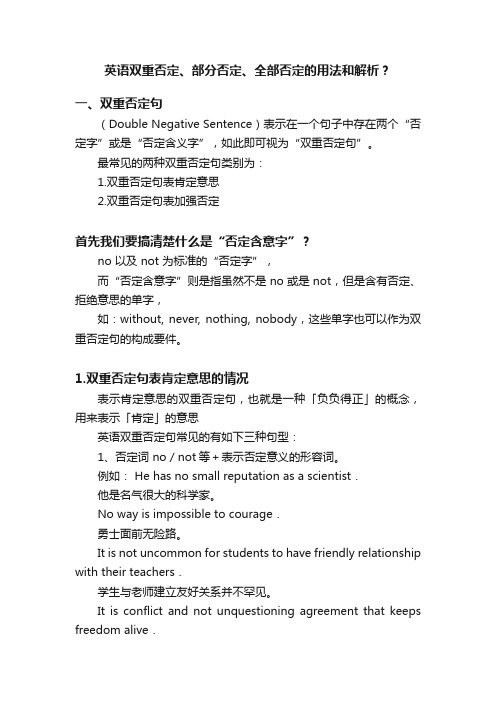
英语双重否定、部分否定、全部否定的用法和解析?一、双重否定句(Double Negative Sentence)表示在一个句子中存在两个“否定字”或是“否定含义字”,如此即可视为“双重否定句”。
最常见的两种双重否定句类别为:1.双重否定句表肯定意思2.双重否定句表加强否定首先我们要搞清楚什么是“否定含意字”?no 以及 not 为标准的“否定字”,而“否定含意字”则是指虽然不是 no 或是 not,但是含有否定、拒绝意思的单字,如:without, never, nothing, nobody,这些单字也可以作为双重否定句的构成要件。
1.双重否定句表肯定意思的情况表示肯定意思的双重否定句,也就是一种「负负得正」的概念,用来表示「肯定」的意思英语双重否定句常见的有如下三种句型:1、否定词 no/not等+表示否定意义的形容词。
例如: He has no small reputation as a scientist.他是名气很大的科学家。
No way is impossible to courage.勇士面前无险路。
It is not uncommon for students to have friendly relationship with their teachers.学生与老师建立友好关系并不罕见。
It is conflict and not unquestioning agreement that keeps freedom alive.使自由保持活力的是冲突而不是绝对的一致。
Nothing is unnecessary.没有什么是不必要的。
2、否定词 no/not/never等+without…We cannot succeed without your help.没有你们的帮助,我们就不能成功。
They never meet without quarreling.他们每次见面必吵架。
(人教版全册)2022届九年级中考英语专题复习否定的几种表示方
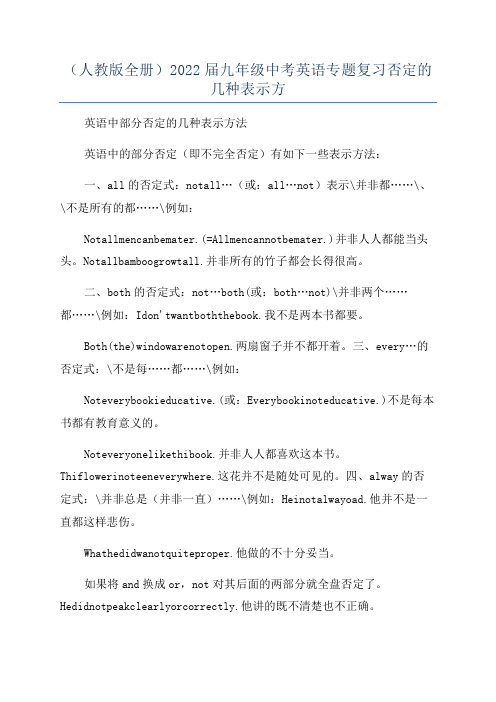
(人教版全册)2022届九年级中考英语专题复习否定的几种表示方英语中部分否定的几种表示方法英语中的部分否定(即不完全否定)有如下一些表示方法:一、all的否定式:notall…(或:all…not)表示\并非都……\、\不是所有的都……\例如:Notallmencanbemater.(=Allmencannotbemater.)并非人人都能当头头。
Notallbamboogrowtall.并非所有的竹子都会长得很高。
二、both的否定式:not…both(或:both…not)\并非两个……都……\例如:Idon'twantboththebook.我不是两本书都要。
Both(the)windowarenotopen.两扇窗子并不都开着。
三、every…的否定式:\不是每……都……\例如:Noteverybookieducative.(或:Everybookinoteducative.)不是每本书都有教育意义的。
Noteveryonelikethibook.并非人人都喜欢这本书。
Thiflowerinoteeneverywhere.这花并不是随处可见的。
四、alway的否定式:\并非总是(并非一直)……\例如:Heinotalwayoad.他并不是一直都这样悲伤。
Whathedidwanotquiteproper.他做的不十分妥当。
如果将and换成or,not对其后面的两部分就全盘否定了。
Hedidnotpeakclearlyorcorrectly.他讲的既不清楚也不正确。
Allofthemcandoit.---Noneofthemcandoit.Botharegood.---Neitherigood.Everybodylikeit.---Nobodylikeit.Heialwaylate.---Heineverlate.。
英语中的部分否定与全部否定
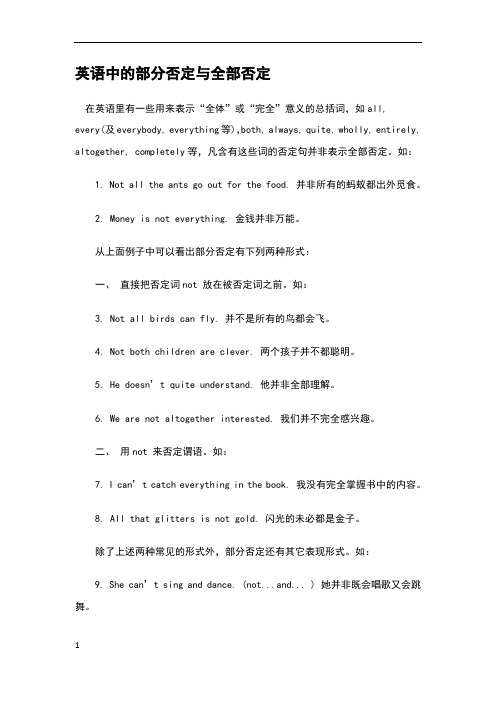
英语中的部分否定与全部否定在英语里有一些用来表示“全体”或“完全”意义的总括词,如all,every(及everybody, everything等),both, always, quite, wholly, entirely, altogether, completely等,凡含有这些词的否定句并非表示全部否定。
如:1. Not all the ants go out for the food. 并非所有的蚂蚁都出外觅食。
2. Money is not everything. 金钱并非万能。
从上面例子中可以看出部分否定有下列两种形式:一、直接把否定词not 放在被否定词之前。
如:3. Not all birds can fly. 并不是所有的鸟都会飞。
4. Not both children are clever. 两个孩子并不都聪明。
5. He doesn’t quite understand. 他并非全部理解。
6. We are not altogether interested. 我们并不完全感兴趣。
二、用not 来否定谓语。
如:7. I can’t catch everything in the book. 我没有完全掌握书中的内容。
8. All that glitters is not gold. 闪光的未必都是金子。
除了上述两种常见的形式外,部分否定还有其它表现形式。
如:9. She can’t sing and dance. (not...and... ) 她并非既会唱歌又会跳舞。
10. It was not for nothing that she spent two years studying skies. (not for nothing) 她花了两年时间研究天体并非毫无收获。
还有含有seldom, hardly, little 等词的句子也有表示部分否定的情况。
11. He seldom asks for leave. 他很少请假。
部分否定和全部否定的讲解
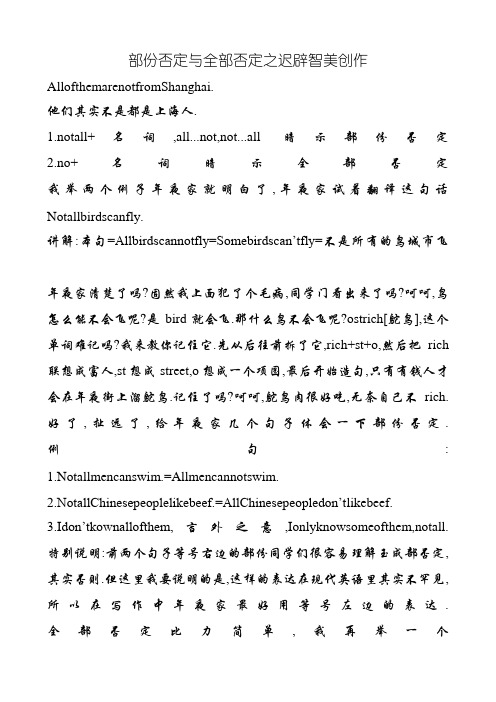
部份否定与全部否定之迟辟智美创作AllofthemarenotfromShanghai.他们其实不是都是上海人.1.notall+名词,all...not,not...all暗示部份否定2.no+名词暗示全部否定我举两个例子年夜家就明白了,年夜家试着翻译这句话Notallbirdscanfly.讲解:本句=Allbirdscannotfly=Somebirdscan’tfly=不是所有的鸟城市飞年夜家清楚了吗?固然我上面犯了个毛病,同学门看出来了吗?呵呵,鸟怎么能不会飞呢?是bird就会飞.那什么鸟不会飞呢?ostrich[鸵鸟],这个单词难记吗?我来教你记住它.先从后往前拆了它,rich+st+o,然后把rich 联想成富人,st想成street,o想成一个项圈,最后开始造句,只有有钱人才会在年夜街上溜鸵鸟.记住了吗?呵呵,鸵鸟肉很好吃,无奈自己不rich.好了,扯远了,给年夜家几个句子体会一下部份否定. 例句:1.Notallmencanswim.=Allmencannotswim.2.NotallChinesepeoplelikebeef.=AllChinesepeopledon’t likebeef.3.Idon’tkownallofthem,言外之意,Ionlyknowsomeofthem,notall. 特别说明:前两个句子等号右边的部份同学们很容易理解玉成部否定,其实否则.但这里我要说明的是,这样的表达在现代英语里其实不罕见,所以在写作中年夜家最好用等号左边的表达. 全部否定比力简单,我再举一个Nomencanfly.[这个不是病句,是真理,没人反对吧,自己水平有限,太难的句子怕写错了]中学英语教材中,英语的否定句是一个语法的重点,同时又是一个难点.在教学中发现有很多学生对英语句子的全部否定和部份否定翻译时不够准确,年夜部份学生是依照字面翻译.英汉互译时,遣词禁绝,不注重英汉语言的习惯表达法.这样既影响了学生对文章中的语句理解的准确性,又影响了学生运用英语的能力.笔者就中学英语的否定句类型浅谈全部否定和部份否定句的英汉互译.英语中的否定句,就其否定的范围来说,可分为全部否定(CompleteNegation)和部份否定(PartialNegation).暗示全部否按时,经常使用含“绝无”意义的否定词(如:none/no/neither/nobody/nothing/never/nowhere等)加上肯定式谓语.例如:Noneofthean-swersarecorrect.全部谜底都不正确.Neitherofthefilmsisinteresting.这两部片子都无趣味.Nothingintheworldisdifficultforonewhosetshismindtoit.世上无难事,只怕有心人.InevercametovisitShanghaiinthepast.过去我从未来观赏上海.Thisumbrellawasnowheretobefound.这把伞哪里也找不到了.NobodyelsebutIwent.除我以外,谁也没去.Nopains,nogains.不劳则无获.暗示部份否按时,除用含“部份”意义的代词、副词(如:some,somebody,something,somewhere,some-what等)加上否定谓语(如:Someworkersaren′texpe-rienced.)以外,还有其它特殊的表达法.①“all,every,both…+not…”结构.此结构在英语中使用最广泛.其意思是部份否定,与中文“不是全部”、“不是每个都”、“不是两者都”相当.如果否定词not放置这些词之前(如:notall…,notevery…,notboth…),就更加能突出其部份否定的意思.这种新颖的用法尤其在美国英语中用得普遍.例如:Allisnotgoldthatglitters.=Notallthatglittersisgold.发光的其实不都是金子.Idon′tknowbothofthem.=Iknownotbothofthem.他们俩我不都认识.Everybodywouldn′tlikeit.=Noteverybodywouldlikeit.其实不是每个人城市喜欢它.Allthenewsisnottrue.这些消息其实不都是真实的.Idon′trememberallthesewords.我其实不全都记得这些话.Hedoesn′tknoweverythingaboutit.=Heknowsnoteverythingaboutit.对此他其实不完全了解情况.②“many,always,much,everywhere,wholly,entire-ly,altogether+not”结构.例如:Theyhaven′tgotmuchnewsyet.他们还没有获得很多消息.Therearenotmanypeoplewhocansingthissong.能够唱这首歌的人其实未几.Hewasnotentirelyhappy.他其实不感到十分高兴.Suchabookisnotfoundeverywhere.这类书其实不是处处都有.Thisisnotalwaysgoodinstructivefilm.这部片子其实不是有很好教育意义的片子.从某种意义上讲:notalways=sometimes;notev-erywhere=somewhere;notwholly=insomedegree;notaltogether=somewhat.③…not…+adverbial(attributive,complement)+and+adverbial(attributive?熏complement)”结构.在这个结构中,“and”在否定句中,若连接两个状语或定语或表语时,与之搭配的“not”有时只暗示部份否定,即只否定“and”后面的部份.例如:ThatTVplayisnotinterestingandinstructive.那部电视剧虽有趣味,但没有教育意义.Shedidn′texplainthistextcorrectlyorclearly.她对这篇课文解释得很正确,但不够清楚.上述两例中的“and”,如果换用“or”,就酿成了全部否定了.ThatTVplayisnotinterestingorinstructive.那部电视剧既没有趣味,也无教育意义.Shedid′texplainthistextcorrectlyorclearly.她对这篇课文既没有解释得很正确,也没有解释得很清楚.④“…not…+…aswellas…”结构在这个结构中,not只否定它前面的部份,暗示部份肯定.而aswellas后面的部份则暗示“肯定”.例如:Hedoesn′tdanceaswellassing.他唱歌,但不跳舞.Thechildisn′tlivelyaswellashealthy.这个孩子健康,但不活泼.若把上述例句中not去失落,酿成肯定句,就即是notonly…butalso.例如:Hedancesaswellassings.他跳舞唱歌同样优美.Thechildislivelyaswellashealthy.这个孩子既健康又活泼.总之,英语中的否定表达形式很丰富,本文仅仅起着举一反三、举一反三和抛砖引玉的目的.请看下面这个句子:Thisisourfirstlesson,soIdon'tknowallyournames.这一句的后半部份该怎样理解呢?究竟是“你们的名字我全不知道”还是“你们的名字我不全知道”呢?很多学生对此感到茫然.这就涉及到英语中的部份否定和全部否定.上面这个看似全部否定的句子,其实暗示的是部份否定.在英语中all,both,every,everyone,everything等与否定词not连用时,暗示的是部份否定,而非全部否定.例如:Idon'tknowallofthem.我其实不全认识他们.Idon'tlikebothofthebooks.这两本书我其实不都喜欢. NoteverystudentgoestothefarmonSundays.其实不是每个学生星期天都去农场.Noteveryoneinourclasslikesfootball.在我们班其实不是每个人都喜欢足球.若要暗示全部否定,则应用相应的暗示全部否定的否定词.如:all→none(一个人也没有、没有任何工具),both→neither(两个都不),every→no,everyone→noone(nobody),everything→nothing 等.上述四个例句要暗示全部否定应分别为:Iknownoneofthem.他们我都不认识.Ilikeneitherofthebooks.这两本书我都不喜欢. NostudentgoestothefarmonSundays.星期天没有学生去农场.Noone/Nobodyinourclasslikesfootball.我们班没有人喜欢足球.★部份否定:当not与all,every,both等连用时,暗示部份否定.not可以放在这些词前,也可以放在句中.[例句]Notallofthemknowtheanswer.=Allofthemdon’tknowtheanswer.=Someofthemknowtheanswer,andtheothersdon’tknowtheanswer.其实不是他们所有的人都知道谜底.Notbothsentencesarewrong.=Bothsentencesarenotwrong.=Oneofthetwosentencesiswrongandtheotheriscorrect.其实不是两个句子都错了.★全部否定:用相应的暗示全部否定的否定词,如:none,noone,no,neither等.[例句]Noneofthemknow(s)theanswer.他们中没有人知道谜底.Neitherofthesentencesis/arewrong.那两个句子都不错.[小试]试把下列句子译成汉语.1.Allbirdshavewings,butnotallbirdscanfly.2.Everystudentcannotpasstheexam.Key:1.所有的鸟都有同党,但其实不是所有的鸟城市飞.2.其实不是所有的学生都可以通过这次测试.3.两扇窗户都没开.请看下面这个句子:Thisisourfirstlesson,soIdon'tknowallyournames.这一句的后半部份该怎样理解呢?究竟是“你们的名字我全不知道”还是“你们的名字我不全知道”呢?很多学生对此感到茫然.这就涉及到英语中的部份否定和全部否定.上面这个看似全部否定的句子,其实暗示的是部份否定.在英语中all,both,every,everyone,everything等与否定词not连用时,暗示的是部份否定,而非全部否定.例如:Idon'tknowallofthem.我其实不全认识他们.Idon'tlikebothofthebooks.这两本书我其实不都喜欢. NoteverystudentgoestothefarmonSundays.其实不是每个学生星期天都去农场.Noteveryoneinourclasslikesfootball.在我们班其实不是每个人都喜欢足球.若要暗示全部否定,则应用相应的暗示全部否定的否定词.如:all→no ne(一个人也没有、没有任何工具),both→neither(两个都不),every→no,everyone→noone(nobody),everything→nothing 等.上述四个例句要暗示全部否定应分别为:Iknownoneofthem.他们我都不认识.Ilikeneitherofthebooks.这两本书我都不喜欢. NostudentgoestothefarmonSundays.星期天没有学生去农场.Noone/Nobodyinourclasslikesfootball.我们班没有人喜欢足球.部份否定是高中阶段重要的语法之一,对它的正确理解和分析有助于我们对文章的理解,而且可以提高解题的准确性.在高一上册的教材中就屡次呈现过含部份否定的句子.如在Unit7中有这样的句子:Perhapsthisisnotalwaystrue,but...句意为:这话也许不总是正确,但……在Unit12中还有:...thatnotallofthemweresafe.意为:……但它们其实不都是平安的.下面就结合例子来简要分析部份否定的要点及用法:在英语里有一些用来暗示“全体”或“完全”意义的总括词,如all,every(及everybody,everything等),both,always,quite,wholly,entirely,altogether,completely等,凡含有这些词的否定句其实不是暗示全部否定.如:1.Notalltheantsgooutforthefood.其实不是所有的蚂蚁都出外觅食.2.Moneyisnoteverything.金钱其实不是万能.从上面例子中可以看出部份否定有下列两种形式:一、直接把否定词not放在被否定词之前.如:3.Notallbirdscanfly.其实不是所有的鸟城市飞.4.Notbothchildrenareclever.两个孩子其实不都聪慧.5.Hedoesn’tquiteunderstand.他其实不是全部理解.6.Wearenotaltogetherinterested.我们其实不完全感兴趣.二、用not来否定谓语.如:7.Ican’tcatcheverythinginthebook.我没有完全掌握书中的内容.8.Allthatglittersisnotgold.闪光的未必都是金子.除上述两种罕见的形式外,部份否定还有其它暗示形式.如:9.Shecan’tsinganddance.(not...and...)她其实不是既会唱歌又会跳舞.10.Itwasnotfornothingthatshespenttwoyearsstudyingskies.(notfornothing)她花了两年时间研究天体其实不是毫无收获.还有含有seldom,hardly,little等词的句子也有暗示部份否定的情况.11.Heseldomasksforleave.他很少请假.12.IthardlyeversnowsinGuangdong.广东极少下雪.13.Weknowfewofthem.他们傍边我们不认识几个人.14.Thereislittleinkinthebottle.瓶里没有几多墨水.必需指出的是,若总括词后呈现带有否定词缀的词或含有否定概念的词时,总括词所在的句子则暗示“全部否定”.试比力:15.Allpeopleherearenotfriendly.这里所有的人其实不都很友好.(部份否定)Allpeoplehereareunfriendly.这里所有的人都不友好.(全部否定)16.Notalwayswasshekindtous.她其实不总是对我们客气.(部份否定) Shewasalwaysunkindtous.她对我们总是不客气.(全部否定)又如:Hefailedineverythinghedid.(=Hesucceededinnothinghedid.)他所做的事全都失败了.总之,只有通过多做多练才华识别出部份否定和全部否定的分歧含义,以便对句子和文章能有更好的理解.楼层: 1[思路分析]分析如下[解题过程]英语中的部份否定(即不完全否定)有如下一些暗示方法:一、 all 的否定式:not all…(或:all…not)暗示\"其实不是都……\"、\"不是所有的都……\"例如:Not all men can be masters. (= All men cannot be masters.) 其实不是人人都能当头头.Not all bamboo grows tall. 其实不是所有的竹子城市长很高.二、 both 的否定式:not…both (或:both… not) \"其实不是两个……都……\" 例如:I don\'t want both the books. 我不是两本书都要.Both (the) windows are not open. 两扇窗子其实不都开着.三、 every…的否定式:\"不是每……都……\" 例如:Not every book is educative. (或:Every book is not educative.) 不是每本书都有教育意义的.Not everyone likes this book. 其实不是人人都喜欢这本书.This flower is not seen everywhere. 这花其实不是随处可见的.四、 always的否定式:\"其实不是总是(其实不是一直)……\" 例如:He is not always so sad. 他其实不是一直都这样哀思.五、 entirely, altogether, completely 和quite 的否定式:\"不完全……\",\"其实不是完全……\" 例如:The businessman is never to be entirely trusted. 不成以完全信任商人. He felt not altogether satisfied. 他其实不完全满意.I don\'t agree completely. 我其实不完全同意.What he did was not quite proper. 他做的不十分妥当.六、 all the time 的否定式:\"其实不是一直……\"、\"未必老是……\" 例如:A foolish man doesn\'t make a mistake all the time. 笨人未必老是犯毛病.七、 not…and…的否定式,被否定的往往是and后面的那一部份. 例如:He did not speak clearly and correctly. 他讲得清楚但不正确.This film is not interesting and instructive. 这部片子有趣但无教育意义. She cannot sing and dance. 她会唱歌但不会跳舞.如果将and 换成or,not 对其后面的两部份就全盘否定了.He did not speak clearly or correctly. 他讲的既不清楚也不正确.如要对上述的all, both, every, always, 以及entirely, altogether, completely, quite 和 all the time 等词作完全否定,那就分别要用与之相对应的全否定词,如no, none, neither, no one, never, not (never)… at all 等.例如:All of them can do it.--- None of them can do it.Both are good.---Neither is good.Everybody likes it. ---Nobody likes it.He is always late. --- He is never late.We don\'t trust them entirely. --- We never trust them at all.He was here all the time. --- He was never here.楼层: 1[思路分析]分析如下[解题过程]英语中的部份否定(即不完全否定)有如下一些暗示方法:一、 all 的否定式:not all…(或:all…not)暗示\"其实不是都……\"、\"不是所有的都……\"例如:Not all men can be masters. (= All men cannot be masters.) 其实不是人人都能当头头.Not all bamboo grows tall. 其实不是所有的竹子城市长很高.二、 both 的否定式:not…both (或:both… not) \"其实不是两个……都……\" 例如:I don\'t want both the books. 我不是两本书都要.Both (the) windows are not open. 两扇窗子其实不都开着.三、 every…的否定式:\"不是每……都……\" 例如:Not every book is educative. (或:Every book is not educative.) 不是每本书都有教育意义的.Not everyone likes this book. 其实不是人人都喜欢这本书.This flower is not seen everywhere. 这花其实不是随处可见的.四、 always的否定式:\"其实不是总是(其实不是一直)……\" 例如:He is not always so sad. 他其实不是一直都这样哀思.五、 entirely, altogether, completely 和quite 的否定式:\"不完全……\",\"其实不是完全……\" 例如:The businessman is never to be entirely trusted. 不成以完全信任商人. He felt not altogether satisfied. 他其实不完全满意.I don\'t agree completely. 我其实不完全同意.What he did was not quite proper. 他做的不十分妥当.六、 all the time 的否定式:\"其实不是一直……\"、\"未必老是……\" 例如:A foolish man doesn\'t make a mistake all the time. 笨人未必老是犯毛病.七、 not…and…的否定式,被否定的往往是and后面的那一部份. 例如:He did not speak clearly and correctly. 他讲得清楚但不正确.This film is not interesting and instructive. 这部片子有趣但无教育意义. She cannot sing and dance. 她会唱歌但不会跳舞.如果将and 换成or,not 对其后面的两部份就全盘否定了.He did not speak clearly or correctly. 他讲的既不清楚也不正确.如要对上述的all, both, every, always, 以及entirely, altogether, completely, quite 和 all the time 等词作完全否定,那就分别要用与之相对应的全否定词,如no, none, neither, no one, never, not (never)… at all 等.例如:All of them can do it.--- None of them can do it.Both are good.---Neither is good.Everybody likes it. ---Nobody likes it.He is always late. --- He is never late.We don\'t trust them entirely. --- We never trust them at all.He was here all the time. --- He was never here.请看下面这个句子:This is our first lesson, so I don't know all your names.这一句的后半部份该怎样理解呢?究竟是“你们的名字我全不知道”还是“你们的名字我不全知道”呢?很多学生对此感到茫然.这就涉及到英语中的部份否定和全部否定.上面这个看似全部否定的句子,其实暗示的是部份否定.[1]Not独自使用,暗示全部否定,可是在英语中 all , both,every, everyone, everything 等与否定词 not 连用时,暗示的是部份否定,而非全部否定.例如:I don't know all of them. 我其实不全认识他们.I don't like both of the books. 这两本书我其实不都喜欢.Not every student goes to the farm on Sundays. 其实不是每个学生星期天都去农场.Not everyone in our class likes football. 在我们班其实不是每个人都喜欢足球.[2] 若要暗示全部否定,则应用相应的暗示全部否定的否定词.如: all → none (一个人也没有、没有任何工具), both → neither (两个都不), every → no, everyone → no one(nobody), everything →nothing 等.上述四个例句要暗示全部否定应分别为:I know none of them. 他们我都不认识.I like neither of the books. 这两本书我都不喜欢.No student goes to the farm on Sundays. 星期天没有学生去农场.No one/ Nobody in our class likes football. 我们班没有人喜欢足球.。
部分否定的易错考点解析及就近原则讲解
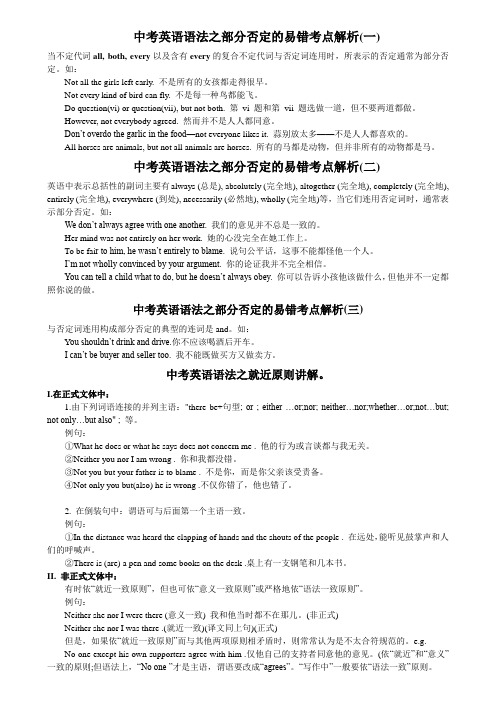
中考英语语法之部分否定的易错考点解析(一)当不定代词all, both, every以及含有every的复合不定代词与否定词连用时,所表示的否定通常为部分否定。
如:Not all the girls left early. 不是所有的女孩都走得很早。
Not every kind of bird can fly. 不是每一种鸟都能飞。
Do question(vi) or question(vii), but not both. 第vi 题和第vii 题选做一道,但不要两道都做。
However, not everybody agreed. 然而并不是人人都同意。
Don’t overdo the garlic in the food—not everyone likes it. 蒜别放太多——不是人人都喜欢的。
All horses are animals, but not all animals are horses. 所有的马都是动物,但并非所有的动物都是马。
中考英语语法之部分否定的易错考点解析(二)英语中表示总括性的副词主要有always (总是), absolutely (完全地), altogether (完全地), completely (完全地), entirely (完全地), everywhere (到处), necessarily (必然地), wholly (完全地)等,当它们连用否定词时,通常表示部分否定。
如:We don’t always agree with one another. 我们的意见并不总是一致的。
Her mind was not entirely on her work. 她的心没完全在她工作上。
To be fai r to him, he wasn’t entirely to blame. 说句公平话,这事不能都怪他一个人。
I’m not wholly convinced by your argument. 你的论证我并不完全相信。
中考英语专题复习 否定的几种表示方法 人教新目标版(1)
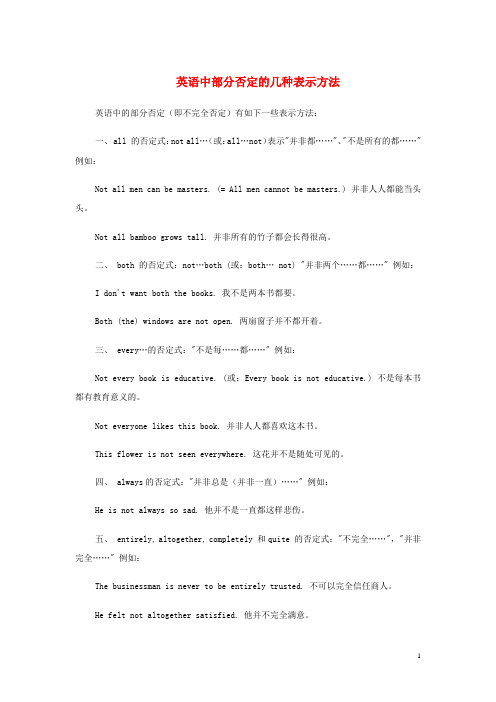
英语中部分否定的几种表示方法英语中的部分否定(即不完全否定)有如下一些表示方法:一、 all 的否定式:not all…(或:all…not)表示"并非都……"、"不是所有的都……"例如:Not all men can be masters. (= All men cannot be masters.) 并非人人都能当头头。
Not all bamboo grows tall. 并非所有的竹子都会长得很高。
二、 both 的否定式:not…both (或:both… not) "并非两个……都……" 例如:I don't want both the books. 我不是两本书都要。
Both (the) windows are not open. 两扇窗子并不都开着。
三、every…的否定式:"不是每……都……" 例如:Not every book is educative. (或:Every book is not educative.) 不是每本书都有教育意义的。
Not everyone likes this book. 并非人人都喜欢这本书。
This flower is not seen everywhere. 这花并不是随处可见的。
四、 always的否定式:"并非总是(并非一直)……" 例如:He is not always so sad. 他并不是一直都这样悲伤。
五、 entirely, altogether, completely 和quite 的否定式:"不完全……","并非完全……" 例如:The businessman is never to be entirely trusted. 不可以完全信任商人。
He felt not altogether satisfied. 他并不完全满意。
英语中的部分否定与全部否定
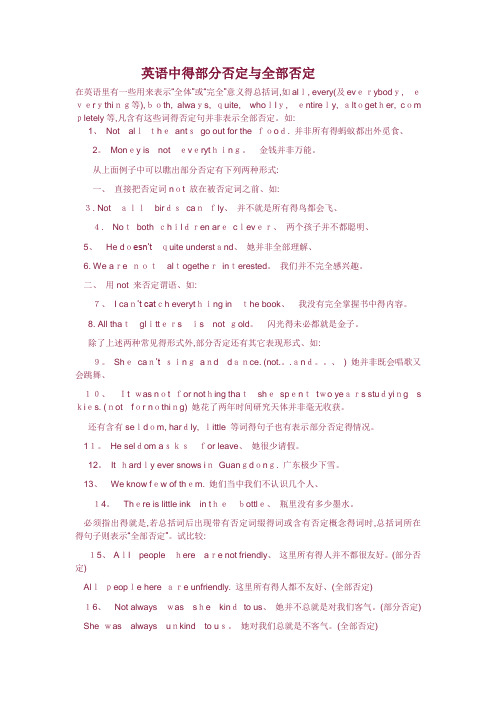
英语中得部分否定与全部否定在英语里有一些用来表示“全体”或“完全”意义得总括词,如all, every(及everybody,everything等),both, always, quite,wholly,entirely, altogether, com pletely等,凡含有这些词得否定句并非表示全部否定。
如:1、Not alltheantsgo out for the food. 并非所有得蚂蚁都出外觅食、2。
Money is noteverything。
金钱并非万能。
从上面例子中可以瞧出部分否定有下列两种形式:一、直接把否定词not 放在被否定词之前、如:3. Notallbirdscanfly、并不就是所有得鸟都会飞、4.Notboth children areclever、两个孩子并不都聪明、5、He doesn’tquite understand、她并非全部理解、6. We are notaltogetherinterested。
我们并不完全感兴趣。
二、用not 来否定谓语、如:7、I can’t catch everything inthe book、我没有完全掌握书中得内容。
8. All thatglittersis not gold。
闪光得未必都就是金子。
除了上述两种常见得形式外,部分否定还有其它表现形式、如:9。
Shecan’t singand dance. (not.。
.and。
、) 她并非既会唱歌又会跳舞、10、It was not for nothing thatshespenttwo years studying s kies. (not for nothing) 她花了两年时间研究天体并非毫无收获。
还有含有seldom, hardly, little 等词得句子也有表示部分否定得情况。
11。
He seldom asksfor leave、她很少请假。
12。
It hardly ever snows inGuangdong. 广东极少下雪。
英语:高考英语中的八种否定形式,万不可混淆
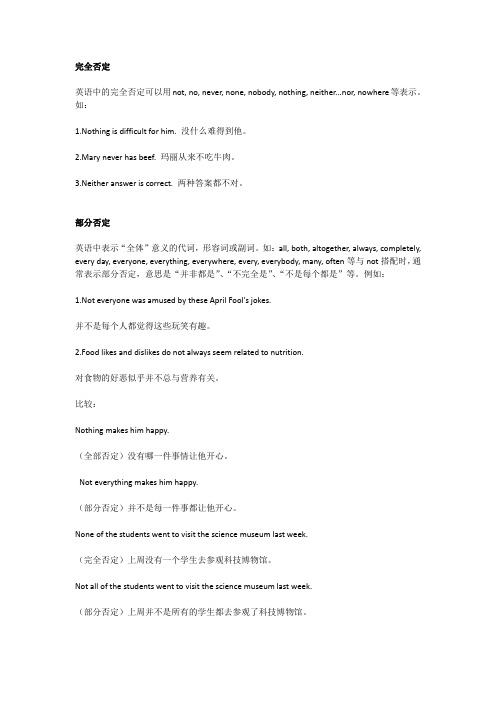
完全否定英语中的完全否定可以用not, no, never, none, nobody, nothing, neither...nor, nowhere等表示。
如:1.Nothing is difficult for him. 没什么难得到他。
2.Mary never has beef. 玛丽从来不吃牛肉。
3.Neither answer is correct. 两种答案都不对。
部分否定英语中表示“全体”意义的代词,形容词或副词。
如:all, both, altogether, always, completely, every day, everyone, everything, everywhere, every, everybody, many, often等与not搭配时,通常表示部分否定,意思是“并非都是”、“不完全是”、“不是每个都是”等。
例如:1.Not everyone was amused by these April Fool's jokes.并不是每个人都觉得这些玩笑有趣。
2.Food likes and dislikes do not always seem related to nutrition.对食物的好恶似乎并不总与营养有关。
比较:Nothing makes him happy.(全部否定)没有哪一件事情让他开心。
Not everything makes him happy.(部分否定)并不是每一件事都让他开心。
None of the students went to visit the science museum last week.(完全否定)上周没有一个学生去参观科技博物馆。
Not all of the students went to visit the science museum last week.(部分否定)上周并不是所有的学生都去参观了科技博物馆。
- 1、下载文档前请自行甄别文档内容的完整性,平台不提供额外的编辑、内容补充、找答案等附加服务。
- 2、"仅部分预览"的文档,不可在线预览部分如存在完整性等问题,可反馈申请退款(可完整预览的文档不适用该条件!)。
- 3、如文档侵犯您的权益,请联系客服反馈,我们会尽快为您处理(人工客服工作时间:9:00-18:30)。
中考英语- 最易混淆的完全否定与部分否定
一. 完全否定
英语中的完全否定可以用not, no, never, none, nobody, nothing, neither...nor, nowhere 等表示。
如:
1. Nothing is difficult for him. 没什么难得到他。
2. Mary never has beef. 玛丽从来不吃牛肉。
3. Neither answer is correct. 两种答案都不对。
二.部分否定
英语中表示“全体”意义的代词, 形容词或副词。
如:all, both, altogether, always, completely, every day, everyone, everything, everywhere, every, everybody, many, often 等与not 搭配时,通常表示部分否定,意思是“并非都是” “不完全是” “不是每个都是”等。
例如:
1. Not everyone was amused by these April Fool's jokes.
并不是每个人都觉得这些玩笑有趣。
2. Food likes and dislikes do not always seem related to nutrition. 对食物
的好恶似乎并不总与营养有关。
比较:
Nothing makes him happy.
(全部否定)没有哪一件事情让他开心。
Not everything makes him happy.
(部分否定)并不是每一件事都让他开心。
None of the students went to visit the science museum last week. (完全
否定)上周没有一个学生去参观科技博物馆。
Not all of the students went to visit the science museum last week. (部分
否定)上周并不是所有的学生都去参观了科技博物馆。
三.几乎否定
一些半否定词表否定之意。
他们不可再与否定词连用,他们与谓语肯定式连用,构成几乎否定句。
如:hardly, scarcely, seldom, little, few 等词。
例如:
1.I could hardly hear what he said.
我几乎没听见他说了什么
2.There is little water in the bottle, isn't there?
瓶子里几乎没有水,不是吗?
四.双重否定
双重否定句由not + 具有否定意义的词构成,形成“否定+ 否定= 肯定”的语言效果。
双重否定可以表示强调,也可以表示委婉的含义。
例如:
1.Her name can't escape me forever.
我永远忘不了她的名字。
2.The songs never fail to make the children smile.
这些歌曲一向都能使孩子微笑。
五.转移否定
转移否定,即句中的否定虽然出现在谓语部分,否定
范围却不在主句谓语动词本身,而转移到了句子中的
宾语、状语或其他成分上。
这种形式在初中比较常见的有以下两种情况:
1.转移否定多用于表思维活动如:believe(相信), expect(期望), hope(希望),
imagine(想象), think(认为)等。
例如:I don't think he will pass the exam.
我认为他考试会不及格的。
2.主句的谓语动词是表感觉的系动词,通常也用于转移否定句
这类动词有:seem(好像), feel(感觉), appear(出现), look like(看起来像)等。
例如:
It doesn't look like it's going to rain.=It looks like it isn't going to rain. 好
象不会下雨。
No matter how hard he studies, he never seems to be able to pass the
exam. 不管他多么努力的学习,他似乎永远也考不及格。
1.too...to 太⋯⋯而不能
He is too tired to walk. 他太累了,走不动了。
2.more A than B (与其B 不如A)或more than + 含有can 的从句
The young man is more brave than wise.
这年轻人有勇无谋。
The gratitude for your help is more than I can express.
对于你给我的感激之情我无法言表。
3. prefer to do sth rather than do sth
而不愿⋯⋯,例如:
He prefers to write his letters rather than dictate them. 他喜
欢自己写信而不愿口授自己的信。
1. 动词短语表否定意义,如:differ from 与⋯⋯不同prefer...to... 喜欢⋯⋯而不喜欢⋯⋯keep/prevent/stop/protect ... from 阻止,使⋯⋯不keep off 不接近,不让⋯⋯接近lose sight of 看不见例如:
The Great Green Wall stops the sand from moving to the rich land in the south. 绿色长城阻止了风沙吹向南方肥沃的田地。
He lost sight of his wife and went away alone. 他没看见他的妻子,独自走了。
Sally prefers singing to dancing.
莎丽喜欢唱歌而不喜欢跳舞。
2.动词表否定意义
如,absent(缺席), fail(不及格), refuse(拒绝), miss(未赶上,错过), escape (被忘掉)等。
例如:
Why did you absent yourself from school yesterday? 昨天你为什么不来上学?
He missed the 9:30 train and therefore missed the accident.
他没赶上9:30 的那班火车,也因此而逃过那次车祸.
3.介词表否定意义
without(无,没有), against(反对), beyond(超出,无法), except/but(除
外), ⋯⋯past(超过), off(离开), above(超出⋯⋯之外)等。
例如:
I can't finish the work without your help.
没有你的帮助,我完不成这工作。
His conduct has always been above suspicion.
他的行为一直无可置疑。
His stupidity is past all belief.
他的愚蠢简直不可思义。
例如:
WangWei went to bed before he finished his homework.
王伟没完成作业就睡觉了。
Unless you put on your overcoat, you'll catch a cold.
如果你不穿大衣,你就会感冒。
